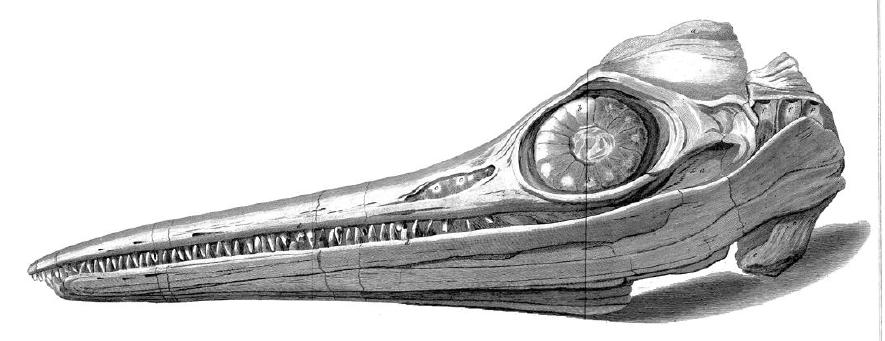 Left destitute by the death of their father in 1810, Mary and her brother Joseph turned to collecting fossils from the local coastline (now styled the Jurassic Coast: see recent Guardian pics) in the hope of selling them to amateur collectors. At the age of twelve, just a few months after her father's death, Mary made a spectacular find that brought her to the attention of the scientific community: the first complete skeleton of an ichthyosaur (a giant "fish lizard") ever found. Although Joseph had found the skull (shown here) a year before, Mary was responsible for locating the rest of the fossil.
Left destitute by the death of their father in 1810, Mary and her brother Joseph turned to collecting fossils from the local coastline (now styled the Jurassic Coast: see recent Guardian pics) in the hope of selling them to amateur collectors. At the age of twelve, just a few months after her father's death, Mary made a spectacular find that brought her to the attention of the scientific community: the first complete skeleton of an ichthyosaur (a giant "fish lizard") ever found. Although Joseph had found the skull (shown here) a year before, Mary was responsible for locating the rest of the fossil.
 Her subsequent discoveries included the first plesiosaur (her own drawing shown here) in 1821 and a remarkable specimen of an extinct ray-finned fish, Dapedium politum, in 1828. Anning also described the first complete skeleton of a flying reptile, the pterosaur Dimorphodon macronyx.
Her subsequent discoveries included the first plesiosaur (her own drawing shown here) in 1821 and a remarkable specimen of an extinct ray-finned fish, Dapedium politum, in 1828. Anning also described the first complete skeleton of a flying reptile, the pterosaur Dimorphodon macronyx.
Later in life, Anning’s fame secured her financial support from the British Association for the Advancement of Science and honorary membership of the Geological Society of London—the only woman in an exclusively male club.
The chief impact of Anning’s work was that her fossils established beyond doubt the concept of extinction, proving that some extinct animals looked nothing like anything alive today. Anning died from breast cancer in her forties and is buried with her brother at St Michael’s Church, Lyme Regis, where a stained-glass window is dedicated to her memory.